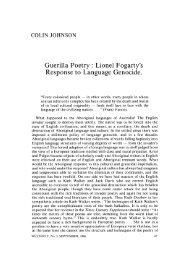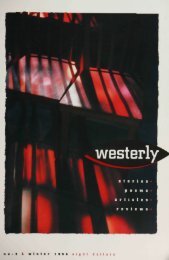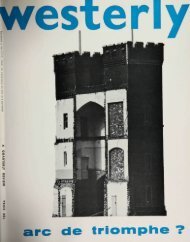You also want an ePaper? Increase the reach of your titles
YUMPU automatically turns print PDFs into web optimized ePapers that Google loves.
JOHN McCALLUMIrish Memories and Australian Hopes:William Butler Yeats and Louis EssonLouis Esson was Australia's first modem playwright. He was also a minor poet,a journalist, critic and commentator on Australian cultural life, but he alwaysregarded his major task to be the creation of a distinctively Australian school ofplaywriting, using distinctively Australian material. He was working, however, inan almost total theatrical vacuum, and his thought came to be dominated by a seriesof nationalist models from throughout the Western world. With hindsight it is notsurprising that he failed, but he is remembered still, for his struggle, if not for hisachievement, as a pioneer.William Yeats was Ireland's first modem playwright. He was also of course a majorpoet, critic and commentator, a cultural hero in the early years of the Irish nationalistliterary movement and a great and charismatic theatrical leader. Yeats created hisown theatre, and to do so he drew on a rich and ancient folk tradition, which herecreated for his own ends, and also on one of the most important new Europeanmodernist movements of his time - Symbolism. Events - political and theatrical- overtook him, but unlike Esson he was for a time, in the theatre and culturalpolitics of his country, leading the field.In this paper I would like to tell the story of the relationship between Yeats andEsson. The central irony of the story is that Esson's nationalism grew out of hisadmiration for his Irish model and his personal devotion to the example of Yeats.This strange combination of nationalism and reliance on overseas models is a featureof each of the three high points of Australian theatre and drama in this century.In the 1950s it was English and in the late 1960s and early 1970s it was Americanbut in the 1920s, when Esson was trying to establish his 'Pioneer Players', it wasIrish. In each case there were other influences, and in each case there was adistinctively Australian flavour to the work, but the central irony - that Australiantheatrical nationalism has always been imported - remains.In the story I am about to tell a further irony arises from the personality of Essonhimself. He was an internationalist by temperament, but under the charismaticleadership of Yeats he turned his attention away from his natural interests to becomea crusading nationalist.To parody the story slightly: Esson was a young Melbourne cosmopolitan, if youcan imagine such a thing, who travelled to Europe in 1905 in search of artisticstimulation in the salons and cafes of Bloomsbury and Montmartre. There he mettwo crazy Irish nationalists who sent him back to the bush and told him to writeabout cows and sheep and mad, lonely boundary riders. Yeats had already pickedup Synge in Paris, where he was writing critical articles about French poets (as Essonhad also done) and had sent him to the Aran islands to do original work. ThenYeats and Synge together picked up Esson, first in London and then again, aftera futile escape attempt, in Paris, and returned him to Australia to try to create afolk theatre of the bush. Esson resisted briefly but he was a very timid man withWESTERLY, No.2, JUNE, 1989 33







